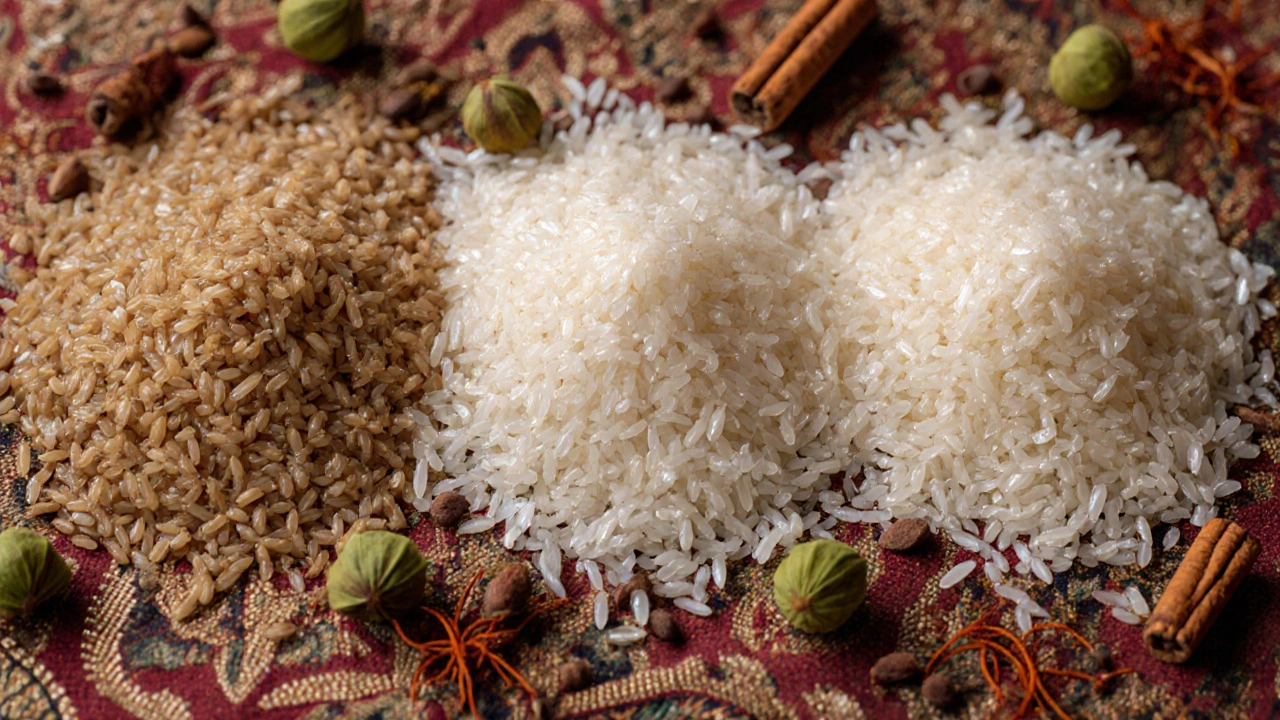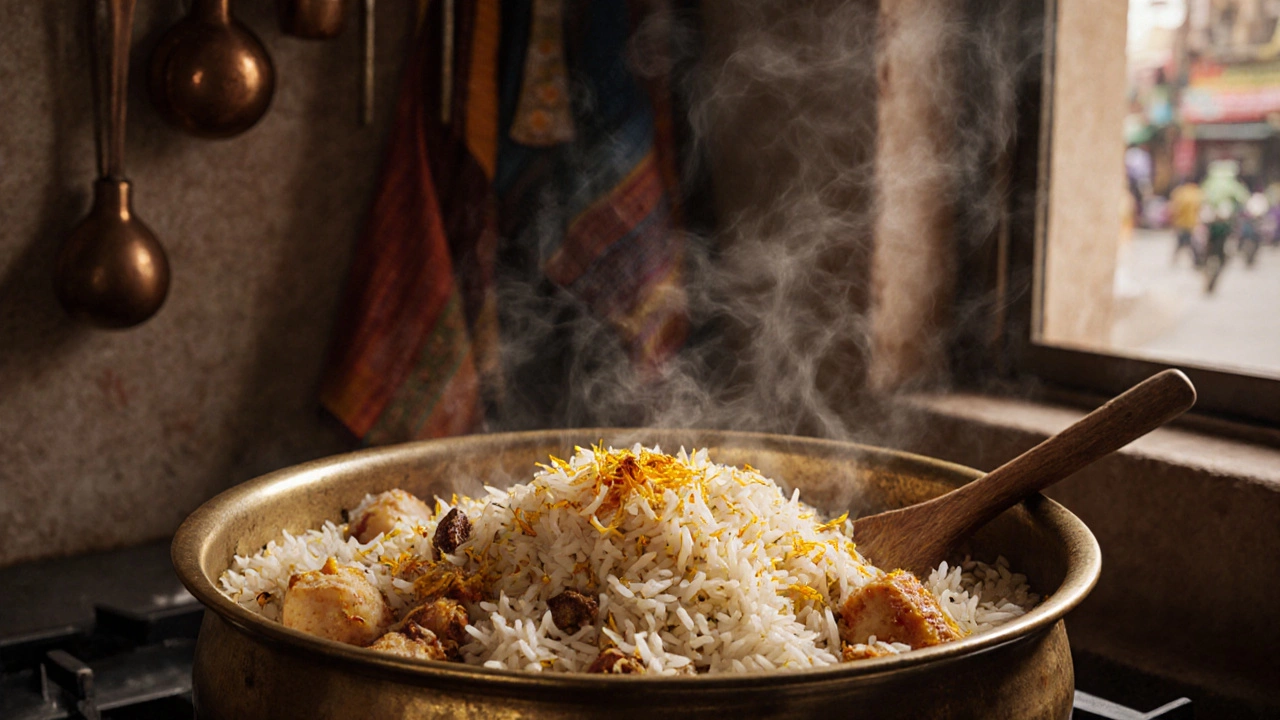Biryani Rice Water Ratio Calculator
Select your rice type and desired texture to calculate the ideal water-to-rice ratio for par-boiling.
Biryani rice is the specific grain used as the base for biryani, a layered rice‑meat dish popular across the Indian subcontinent. The right grain decides whether the final plate is fluffy, aromatic, and holds its shape during the high‑heat "dum" process.
Why the Choice of Rice Matters
When you cook biryani, the rice has to do three heavy lifts: stay separate, absorb the spice‑laden broth, and release a fragrant perfume. A grain that collapses into a mush won’t support those layers, and a bland grain will hide the complex spice blend. That’s why chefs treat the rice selection like a secret ingredient.
Key Rice Varieties Used in Biryani
The market offers many long‑grain options, but only a handful truly shine in biryani. Below are the most common candidates, each introduced with its core attributes.
Basmati rice is a long‑grain rice grown primarily in the Punjab region of India and Pakistan. It’s celebrated for its distinct nutty aroma, slender grains that lengthen up to 2× their original size, and a natural tendency to stay separate after cooking.
Sona Masoori rice is a medium‑long grain cultivated in South India, known for its light texture and lower cost. While it cooks faster, it lacks the deep fragrance of basmati.
Jasmine rice is a Thai aromatic rice with a soft, slightly sticky crumb. Its scent is sweet, but the grain tends to clump, making it less ideal for layered biryani.
Gobindobhog rice is a short‑grain, fragrant rice from West Bengal, often used in sweet dishes. Its plump texture makes it unsuitable for the dry, fluffy profile biryani demands.
Side‑by‑Side Comparison
| Rice Type | Grain Length | Aroma Profile | Typical Aging (years) | Best for Biryani? |
|---|---|---|---|---|
| Basmati | Long (7‑8mm) | Nutty, popcorn‑like | 1‑2 (aged) | ✔️ |
| Sona Masoori | Medium‑Long (6‑7mm) | Mild | 0‑1 (fresh) | ✖️ |
| Jasmine | Long (7‑8mm) | Sweet, floral | 0 (fresh) | ✖️ |
| Gobindobhog | Short (5‑6mm) | Rich, buttery | 0 (fresh) | ✖️ |
How to Prepare the Ideal Biryani Rice
Even the best grain can falter if you mishandle it. Follow these steps for consistently fluffy results.
- Rinse the rice 3-4 times in cold water until the water runs clear. This removes surface starch that causes clumping.
- Soak for 30minutes (or up to 1hour for aged basmati). Soaking allows the grains to elongate evenly during cooking.
- Measure water using the 1:1.5 ratio (1cup rice : 1.5cups water) for par‑boiling. Adjust if you prefer a firmer bite.
- Bring water to a rolling boil, add a pinch of salt, a few whole spices (cumin seeds, cardamom pods), and a teaspoon of ghee. This infuses subtle aroma early on.
- Par‑boil the rice for 5-6minutes-just until it’s 70% cooked. The grains should still have a firm center.
- Tip: Test by biting a grain; it should feel slightly resistant.
- Drain using a fine‑meshed sieve. Let the rice sit for 5minutes to release excess steam.
- Layer the partially cooked rice over the spiced meat or vegetables in a handi, a thick‑bottomed pot traditionally used for biryani. Sprinkle fried onions, saffron‑infused milk, and a drizzle of ghee on top.
- Seal the pot with a tight‑fitting lid or dough‑wrapped foil. Cook on low heat ("dum") for 20-25minutes. The trapped steam finishes the rice, allowing flavors to meld.

Essential Tips & Common Pitfalls
- Age your basmati. Grain that’s been stored for at least a year develops a deeper aroma and resists breakage.
- Never use high heat during the final dum stage. A scorching bottom will make the rice hard and ruin the delicate texture.
- Avoid over‑soaking. Excess water can leach out the natural oils that give basmati its fragrance.
- Use a heavy‑bottomed pot (handi or Dutch oven). Thin metal transfers heat too quickly, causing uneven cooking.
- Don’t stir the rice after layering. Stirring collapses the airy structure built during par‑boiling.
Connecting Rice with the Rest of the Biryani Profile
Rice doesn’t exist in a vacuum. Its success depends on how it interacts with the spice blend, the meat’s cooking liquid, and the aromatics.
The classic garam masala is a heated mix of cinnamon, cloves, cardamom, and black pepper. When the rice meets this aromatically dense broth, each grain becomes a tiny flavor vessel.
Layering with caramelized onions, mint leaves, and a splash of rose water adds depth. The rice’s subtle fragrance complements, rather than competes with, these notes.
When to Swap Basmati for Another Grain
While basmati reigns supreme, there are occasions where an alternative makes sense:
- Budget‑friendly cooking: In large gatherings, a blend of aged basmati and a smaller portion of Sona Masoori can stretch the premium grain without compromising texture.
- Regional authenticity: Hyderabadi biryani often favors 100% aged basmati, whereas Kolkata’s "Kolkata biryani" traditionally includes a hint of Gobindobhog for a slightly richer mouthfeel, though it’s a rare specialty.
- Health considerations: For a lower‑glycemic option, partially polished brown basmati can be used, but the cooking time must be increased by 10‑15minutes.
Wrapping Up
Choosing the right rice is the foundation of a memorable biryani. Aged basmati offers the perfect combo of length, aroma, and resilience, ensuring each grain stays separate and fragrant after the slow‑cook dum. By rinsing, soaking, par‑boiling, and respecting the gentle heat of the dum method, you turn that grain into a plush, aromatic canvas for spices, meat, and herbs.
Frequently Asked Questions
Can I use short‑grain rice for biryani?
Short‑grain rice like Gobindobhog becomes sticky when cooked, which prevents the layered “fluffy” texture biryani needs. It’s best saved for sweet dishes or special regional variations that deliberately embrace a richer mouthfeel.
How long should basmati be aged for optimal biryani?
Traditional recipes call for basmati aged 1-2years. The aging process reduces moisture, sharpens the grain’s aroma, and makes it less prone to breaking during the high‑heat dum stage.
Is it okay to skip rinsing the rice?
Skipping rinses leaves surface starch on the grains, which leads to clumping and a soggy final dish. Even a quick 2‑minute rinse makes a noticeable difference.
What water‑to‑rice ratio works best for biryani?
A 1:1.5 ratio (1cup rice to 1.5cups water) is ideal for par‑boiling basmati. Adjust slightly if using a different grain-Sona Masoori may need a 1:1.25 ratio due to its lower absorption.
Can I use a pressure cooker for the par‑boiling step?
Yes, a pressure cooker set to low pressure for 2minutes can achieve the same 70% doneness, but be careful not to overcook-the rice should still be firm enough to hold its shape during the final dum.
